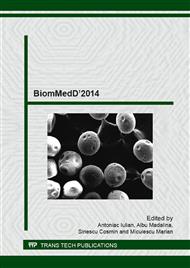[1]
Bacchi A, Consani RL, Mesquita MF, dos Santos MB. Stress distribution in fixed-partial prosthesis and peri-implant bone tissue with different framework materials and vertical misfit levels: a three-dimensional finite element analysis. J Oral Sci. 2013 Sep; 55(3): 239-44.
DOI: 10.2334/josnusd.55.239
Google Scholar
[2]
Pesqueira AA, Goiato MC, Filho HG, Monteiro DR, Santos DM, Haddad MF, Pellizzer EP., Use of stress analysis methods to evaluate the biomechanics of oral rehabilitation with implants. J Oral Implantol. 2014 Apr; 40(2): 217-28.
DOI: 10.1563/aaid-joi-d-11-00066
Google Scholar
[3]
HK Kim, SJ Heo, JY Koak, SK Kim. In vivo comparison of force development with various materials of implant-supported prostheses Journal of Oral Rehabilitation 2009; 36: 616-25.
DOI: 10.1111/j.1365-2842.2009.01972.x
Google Scholar
[4]
Branemark PI. Osseointegration and its experimental background. J Prosthet Dent 1983; 50: 399-410.
Google Scholar
[5]
Abduo J, Bennani V, Waddell N, Lyons K, Swain M. Assessing the fit of implant fixed prostheses: a critical review. Int J Oral Maxillofac Implants 2010; 25: 506-15.
DOI: 10.1111/j.1600-0501.2010.02019.x
Google Scholar
[6]
Schwarz M. Mechanical complications of dental implants. Clin Oral Implants Res 2000; 11: 156–8.
Google Scholar
[7]
Escalante R. Management of occlusion over implants, part 1: three 10-year case follow-ups and evaluations. Dent Today. 2013; 32: 106-111.
Google Scholar
[8]
Bal BT, Cağlar A, Aydin C, Yilmaz H, Bankoğlu M, Eser A. Finite element analysis of stress distribution with splinted and nonsplinted maxillary anterior fixed prostheses supported by zirconia or titanium implants. Int J Oral Maxillofac Implants. 2013 Jan-Feb; 28(1): e27-38.
DOI: 10.11607/jomi.2442
Google Scholar
[9]
Sannino G, Marra G, Feo L, G Vairo, Barlattani A. 3D finite element non linear analysis on the stress state at bone-implant interface in dental osteointegrated implants. Oral Implantol (Rome). 2010 Jul; 3(3): 26-37.
Google Scholar
[10]
Jorge JR, Barão VA, Delben JA, Faverani LP, Queiroz TP, Assunção WG. Titanium in dentistry: historical development, state of the art and future perspectives. J Indian Prosthodont Soc. 2013 Jun; 13(2): 71-7.
DOI: 10.1007/s13191-012-0190-1
Google Scholar
[11]
Lin MC, Tung KL, Lin SC, Huang HH. Bonding of dental porcelain to non-cast titanium with different surface treatments. Dent Mater J. 2012; 31(6): 933-40.
DOI: 10.4012/dmj.2012-073
Google Scholar
[12]
Almilhatti HJ, Neppelenbroek KH, Vergani CE, Machado AL, Pavarina AC, Giampaolo ET. Adhesive bonding of resin composite to various titanium surfaces using different metal conditioners and a surface modification system. J Appl Oral Sci. 2013 Nov-Dec; 21(6): 590-6.
DOI: 10.1590/1679-775720130255
Google Scholar
[13]
Haag P, Nilner K. Bonding between titanium and dental porcelain: a systematic review. Acta Odontol Scand. 2010 May; 68(3): 154-64.
DOI: 10.3109/00016350903575260
Google Scholar
[14]
Chethan Hegde, Krishna Prasad D, Deepmala S, Rakshith Hegde, Implant Restoration Materials: An Overview. International Journal of Oral Implantology and Clinical Research, January-April 2010; 1(1): 43-48.
DOI: 10.5005/jp-journals-10012-1007
Google Scholar
[15]
Larsson C, Vult von Steyern P, Sunzel B, et al. All-ceramic two to five-unit implant-supported reconstructions. A randomized, prospective clinical trial. Swed Dent J 2006; 30: 45-53.
Google Scholar
[16]
Zeynep O¨zkurt, Ender Kazazoglu: Clinical Success of Zirconia in Dental Applications Journal of Prosthodontics xx 2009; 1-5.
Google Scholar
[17]
Sun T, Zhou S, Lai R, Liu R, Ma S, Zhou Z, Longquan S. Load-bearing capacity and the recommended thickness of dental monolithic zirconia single crowns. J Mech Behav Biomed Mater. 2014 Jul; 35: 93-101.
DOI: 10.1016/j.jmbbm.2014.03.014
Google Scholar
[18]
Herrguth M, Wichmann M, Reich S. The aesthetics of all-ceramic veneered and monolithic CAD/CAM crowns. J Oral Rehabil (2005).
DOI: 10.1111/j.1365-2842.2005.01498.x
Google Scholar
[19]
Stawarczyk B, Beuer F, Wimmer T, Jahn D, Sener B, Roos M, Schmidlin PR Polyetheretherketone-a suitable material for fixed dental prostheses? J Biomed Mater Res B Appl Biomater. 2013 Oct; 101(7): 1209-16.
DOI: 10.1002/jbm.b.32932
Google Scholar
[20]
Schwitalla A, Müller WD. PEEK dental implants: a review of the literature. J Oral Implantol. 2013 Dec; 39(6): 743-9.
Google Scholar
[21]
Ma R, Tang T. Current strategies to improve the bioactivity of PEEK. Int J Mol Sci. 2014 Mar 28; 15(4): 5426-45.
Google Scholar
[22]
Escalante Vasquez R. Management of occlusion over implants, part 2: three 10-year case follow-ups and evaluations. Dent Today. 2013 Jul; 32(7): 132, 134-5.
Google Scholar
[23]
Délben JA, Goiato MC, Gennari-Filho H, Gonçalves Assunção W, Dos Santos DM. Esthetics in implant-supported prostheses: a literature review. J Oral Implantol. 2012 Dec; 38(6): 718-22.
DOI: 10.1563/aaid-joi-d-11-00086
Google Scholar
[24]
Skalak R. Biomechanical considerations in osseointegrated prostheses. J Prosthet Dent 1983; 49: 843-48.
Google Scholar
[25]
Bozini T, Petridis H, Garefis K, Garefis P. A meta-analysis of prosthodontic complication rates of implant-supported fixed dental prostheses in edentulous patients after an observation period of at least 5 years. Int J Oral Maxillofac Implants. 26 (2011).
DOI: 10.1111/j.1600-0501.2012.02546.x
Google Scholar
[26]
Jackson RD. The role of modern composites and ceramics in clinical practice. Dent Today. 30 (2011) 58-62.
Google Scholar


